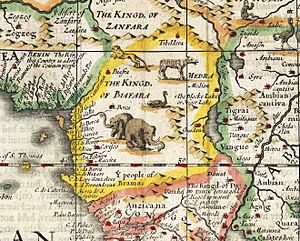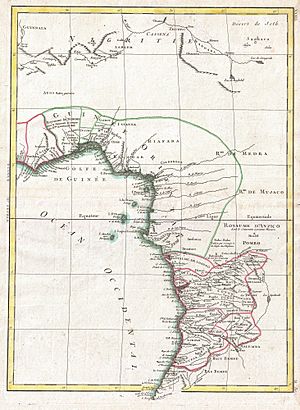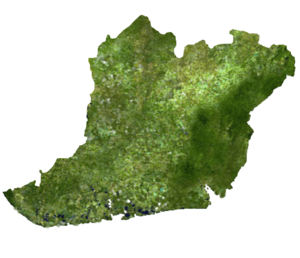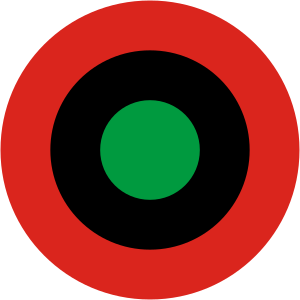Biafra facts for kids
Quick facts for kids
Republic of Biafra
|
|||||||||
|---|---|---|---|---|---|---|---|---|---|
| 1967–1970 | |||||||||
|
Motto: "Peace, Unity, and Freedom."
|
|||||||||
|
Anthem: "Land of the Rising Sun"
|
|||||||||

The Republic of Biafra in red, bordered by its puppet state of the Republic of Benin to the west
|
|||||||||

Republic of Biafra in May 1967
|
|||||||||
| Status | Partially recognised state | ||||||||
| Capital | Enugu (1967) Umuahia (1967–1969) Owerri (1969–1970) Awka (1970) |
||||||||
| Largest city | Onitsha | ||||||||
| Common languages | Predominantly English Igbo Others Ibibio Efik Ejagham Ijaw Ogoni |
||||||||
| Ethnic groups | Igbo (≈67%) Efik Ibibio Ijaw Ogoni |
||||||||
| Demonym(s) | Biafran | ||||||||
| Government | Republic | ||||||||
| President | |||||||||
|
• 1967–1970
|
C. Odumegwu Ojukwu | ||||||||
|
• 1970–1970
|
Philip Effiong | ||||||||
| Historical era | Cold War | ||||||||
|
• Independence declared
|
30 May 1967 | ||||||||
|
• Rejoins Federal Nigeria
|
15 January 1970 | ||||||||
| Area | |||||||||
| 1967 | 77,306 km2 (29,848 sq mi) | ||||||||
| Population | |||||||||
|
• 1967
|
13,500,000 | ||||||||
| Currency | Biafran pound | ||||||||
|
|||||||||
Biafra, also known as the Republic of Biafra, was a country in West Africa. It declared itself independent from Nigeria in 1967. Biafra existed for about three years, until 1970.
The land that became Biafra was mostly the Eastern Region of Nigeria. Many Igbo lived there. On May 30, 1967, a military officer named C. Odumegwu Ojukwu declared Biafra's independence. This happened after many disagreements and difficult events in Nigeria.
Nigeria had gained independence in 1960. But soon, there were ethnic tensions and military takeovers. In 1966, many people from Eastern Nigeria were harmed. This led to Biafra wanting to form its own country.
After Biafra declared independence, Nigeria's military invaded. This started the Nigerian Civil War. Only a few countries officially recognized Biafra as a new nation. These included Gabon, Haiti, Ivory Coast, Tanzania, and Zambia. Other countries like France and Israel offered some support.
Many groups also helped Biafra. These included church organizations and aid groups. One famous group, Médecins Sans Frontières (Doctors Without Borders), started because of the suffering in Biafra.
The war lasted two and a half years. During this time, almost two million Biafran people died. Many of them were young children. They died mostly from starvation because Nigeria blocked supplies from reaching the region.
In 1970, Biafran forces surrendered. Major General Philip Effiong took over leadership after President Ojukwu left. After the war, some Igbo people tried to get their homes back. But a law called the Abandoned Properties Act made it hard. Also, many Biafrans found their bank accounts almost empty.
After the war, some Igbo people started movements to bring Biafra back. Groups like the Indigenous People of Biafra and the Movement for the Actualization of the Sovereign State of Biafra were formed. They wanted Biafra to be an independent country again.
Contents
Exploring Biafra's Past
Where Did the Name "Biafra" Come From?
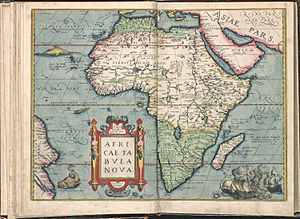
Old maps of Africa from the 1400s to the 1800s show names like Biafar or Biafra. These names described a region in what is now West Cameroon. It included an area near today's Equatorial Guinea.
One old encyclopedia from 1731 even gave the exact location of Biafara's capital. It was near the Rio dos Camaroes in Cameroon. The name "Biafra" also appeared on maps of Senegal and Gambia.
A traveler named Rev. Charles W. Thomas described the islands in the Bight of Biafra. He said they were between certain lines of longitude and latitude.
Why Did the War Start?
Nigeria became independent from the United Kingdom in 1960. Like many new African countries, its borders didn't match ethnic or cultural groups. The northern part of Nigeria was mostly Muslim. The southern part was mostly Christian.
Nigeria was divided into regions based on major ethnic groups. The North had mostly Hausa and Fulani people. The West had mostly Yoruba people. The East had mostly Igbo people.
Over time, ethnic and religious fights started. In 1945, a riot in Jos targeted Igbo people. Many were killed. Another riot happened in Kano in 1953.
In 1964, there were problems during an election. Many people felt the North had too much power. Violence spread. Some people fled from the North and West.
Military Takeovers and Tensions
In January 1966, a group of army officers took over the government. Most of these officers were Igbo. They killed many political leaders, including Nigeria's Prime Minister. The army commander, General Johnson Aguiyi-Ironsi, took charge.
In July 1966, northern officers staged another takeover. They killed General Aguiyi Ironsi and other southern officers. General Yakubu Gowon became the new head of the military government. These events made ethnic tensions even worse.
In September 1966, about 30,000 Igbo people were killed in the north. Some northerners were also killed in eastern cities.
The Aburi Accord and Biafra's Declaration
In January 1967, military leaders met in Ghana. They agreed to make Nigeria less centralized. This agreement was called the Aburi Accords. But when they returned to Nigeria, the federal government changed its mind.
The government created new states. This made some Igbo areas smaller. On May 26, 1967, Ojukwu decided the Eastern Region should leave Nigeria. Four days later, he declared the independence of the Republic of Biafra. He said this was because of the Igbo people killed in the violence.
Another big reason for the conflict was oil. The Biafran region had a lot of oil. Oil was becoming very important to Nigeria's economy. Biafra was not ready for war. It had fewer soldiers and less equipment than Nigeria. But Biafrans were fighting for their homeland.
The Nigerian government attacked Biafra on July 6, 1967. At first, Biafra fought back well. They even took over some areas in August 1967. But Nigeria got help from other countries like Britain, America, and Russia. By October 1967, Nigeria had taken back the land. The war continued with fierce fighting.
Biafra's Land and People
Biafra covered about 29,848 square miles (77,306 square kilometers). It shared borders with Nigeria to the north and west, and with Cameroon to the east. Its coast was on the Gulf of Guinea in the South Atlantic Ocean.
The northeast part of Biafra had hills and mountains leading to Cameroon. Three main rivers flowed from Biafra into the Gulf of Guinea: the Imo River, the Cross River, and the Niger River.
Today, the land that was Biafra is part of several Nigerian states. These include Akwa Ibom, Rivers, Cross River, Bayelsa, Ebonyi, Enugu, Anambra, Imo, Abia, and Delta.
Languages Spoken in Biafra
The people of Biafra spoke many languages. These included Igbo, Anaang, Efik, Ibibio, Ogoni, and Ijaw. However, English was used as the official language for the country.
How Biafra Was Governed
The Republic of Biafra was a single country with emergency rules. It had a president and a cabinet (executive branch). It also had a Ministry of Justice and courts (judicial branch).
Biafra's Economy
One of the first things Biafra did was create its own bank. It was called the Bank of Biafra. This bank handled all money matters, like foreign exchange. It also managed the country's debt. The first governor of the bank was Sylvester Ugoh.
The bank's main office moved several times because of the war. Biafra tried to get foreign money to pay for the war. When Nigeria announced a new currency, Biafra started printing its own money.
On January 28, 1968, the Biafran pound became the new currency. Nigerian money was no longer accepted. The first Biafran banknotes were 5 shillings and 1 pound. Later, new notes for £10, £5, £1, 10 shillings, and 5 shillings were made.
It's thought that about £115–140 million Biafran pounds were in use by the end of the war. This was about £10 for each person in Biafra.
Biafra's Military Forces
At the start of the war, Biafra had only 3,000 soldiers. By the end, they had grown to 30,000. No country officially supported the Biafran Army. But Biafra secretly got weapons. Because of this, they also made many of their own weapons.
Some Europeans fought for Biafra. Rolf Steiner from Germany was a lieutenant colonel. Taffy Williams from Wales was a major. Biafra also created a special guerrilla unit. It was called the Biafran Organization of Freedom Fighters. They attacked Nigerian supply lines.
Biafra's Air Force
Biafra managed to build a small but effective air force. Its commander was Polish pilot Jan Zumbach. They had a few old American bombers from World War II. They also had a converted transport plane.
In 1969, Biafra got five small planes called "Biafra Babies." They were painted green and had rockets. Swedish and Biafran pilots flew them. Later, Biafra got four more planes from America. These were flown by Portuguese pilots until the war ended.
Biafra also had a small, makeshift navy. It was based in Port Harcourt. The navy used captured boats and converted civilian vessels. These boats were armed with machine guns. They mostly operated in the Niger River delta and along the Niger River.
Biafra's Lasting Impact
The international aid group Médecins Sans Frontières (Doctors Without Borders) started because of the suffering in Biafra. French doctors saw how civilians were being harmed and starved. They felt a new aid group was needed. This group would help victims no matter what their politics or religion were.
During the smallpox vaccination campaign in Biafra, there were not enough vaccines. This led to a new way of vaccinating people called "focal vaccination." This method was later used worldwide by the World Health Organization. It helped stop smallpox in West Africa and other places.
Studies in 2010 found that Igbo people born in Biafra during the famine were more likely to have health problems later in life. These included obesity, high blood pressure, and diabetes. This shows how early life experiences can affect health.
A 2017 study found that women exposed to the war when they were young were shorter as adults. They were also more likely to be overweight. They tended to have their first child earlier and had less education. Men exposed to the war married later and had fewer children.
Biafra Today: Nationalism and Activism
After the civil war, groups formed that wanted Biafra to be a country again. The Movement for the Actualization of the Sovereign State of Biafra (MASSOB) started in 1999. It is a nonviolent group. MASSOB believes Nigeria treats Biafran people unfairly.
Since 1999, protests have happened in southeastern Nigeria. Even though they are peaceful, protesters have faced attacks from police and the army. Many people have been killed or arrested.
In 2000, Nigeria's former president, Olusegun Obasanjo, pardoned all military personnel who fought for Biafra. He said this was because "justice must at all times be tempered with mercy."
In 2006, reports said that killings were happening in Onitsha. These were directed at Biafrans, especially MASSOB members. The Nigerian government says MASSOB is violent. MASSOB's leader, Ralph Uwazuruike, has been arrested many times.
In 2009, MASSOB launched an unofficial "Biafran International Passport." They also launched Biafra Plate Numbers in 2016. In 2012, another group, the Supreme Council of Elders of the Indigenous People of Biafra, was formed. They sued Nigeria for the right to self-determination.
MASSOB leader Ralph Uwazuruike started Radio Biafra in the United Kingdom in 2009. Nnamdi Kanu was its director. Kanu was later said to have been dismissed from MASSOB. The Nigerian government has tried to stop Radio Biafra. In 2015, Kanu was arrested and charged with treason. He was released on bail in 2017.
Reports from 2015 and 2016 say that Nigerian security forces killed many pro-Biafran activists. Amnesty International reported that at least 150 activists were killed between August 2015 and August 2016.
Another group is the Biafra Nations League (BNL). It operates near the Bakassi Peninsula. The group has faced arrests by Nigerian soldiers and police. BNL is linked to separatists in Southern Cameroons.
In 2020, the Movement for the Actualization of the Sovereign State of Biafra/Biafra Independence Movement (BIM-MASSOB) joined the Unrepresented Nations and Peoples Organization (UNPO). This organization helps groups that are not fully recognized as countries.
Simon Ekpa and Biafran Activism
Simon Ekpa is a Finnish lawyer and activist. He describes himself as a follower of Nnamdi Kanu. He is the current Prime Minister of the Biafra Republic Government in Exile.
Ekpa's activism gained attention in 2023. There were calls to investigate his activities in Finland. In May 2023, the Universal Peace Federation gave Ekpa an award as an Ambassador for Peace.
See also
 In Spanish: Biafra para niños
In Spanish: Biafra para niños
- Insurgency in Southeastern Nigeria
- Ambazonia
- Half of a Yellow Sun by Chimamanda Ngozi Adichie




